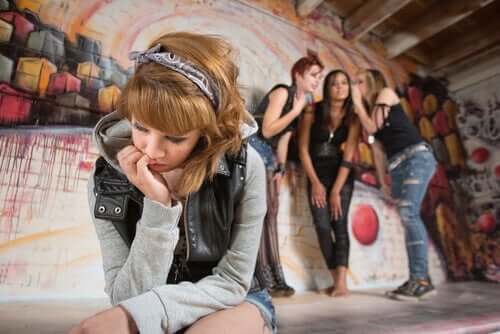Learn All About School Cliques Among Children

Friendships boost children’s self-esteem and autonomy. Children make their first friends at school. These friendships help them learn what it means to share and build relationships outside the family circle. School cliques have a particular influence on them.
What are school cliques?
At school, cliques consist of people who have common interests. They’re small and exclusive societies, meaning that not everyone can be a part of them. They have leaders who decide how things should be done and its members can’t be friends with other people outside the clique.
Characteristics of school cliques
Cliques are different than traditional groups of friends, as they have more specific social dynamics. They reserve the right to refuse admission. They’re exclusive. Children who don’t comply with the rules run the risk of being rejected and expelled from the clique. They even dress alike to show that they’re members of a certain group.
Negative consequences for children
Children who belong to a school clique are under pressure to follow strict rules. They’re identified by a particular jargon and clothing. In addition, they’re sometimes pressured into participating in questionable activities, such as harassing others on the Internet. If they don’t, they can be teased and even suffer from physical violence by their peers.
The fear of being expelled from a school clique can cause anxiety in children. To be a part of that micro-society, they’re forced to wear designer clothes and do things that make them popular. This is most noticeable from 4th and 5th grades, in preadolescence.

The problems school cliques cause
The desire to stand out is very strong in children who are beginning adolescence. Belonging to a school clique can make children become antisocial. Usually, children may experience:
- Mixed feelings and conflicting emotions due to the difficult decision of doing the right or wrong thing.
- Pressure to change their appearance and personality.
- Threats to follow perverse rules, such as discriminating against other children.
- Coercion to participate in small criminal acts.
- Loneliness, anxiety, or depression.
How can I help my children?
The first thing you have to do is meet your children’s school friends. Discover how your children relate to them and the activities they do together. Try to also get to know the parents of their friends and stay in touch with their teachers. Becoming familiar with their school environment will help you discover if your children belong to a school clique.
If you notice that your children are under pressure by such friends, talk calmly and honestly with them to reassure them and put the situation in perspective. Encourage them to tell you their concerns without fear of reprimands.
If you see that your children change their attitude or habits in a short time, this may be a sign of distress. Teach your children that:
- School cliques have always existed.
- Rejection is a part of life. Also, tell them the best way to deal with it.
- Healthy and toxic friendships exist.
- They don’t need to accept manipulation by others to succeed.

Practical ways to develop good friendships
For your children to understand that school cliques limit their happiness, you can resort to striking teaching methods. For example, you can show your children movies or tell them stories that address these issues, where the characters flourish despite the difficulties they face. Talk about similar cases of other children and what happened to them.
Help your children to expand their circle of friends at school. Plan extracurricular activities related to sports, art, or languages to expand your children’s world and allow them to meet more people.
In conclusion, these activities will open your children’s eyes to the world. It’s very healthy for them to learn to socialize in flexible groups of friends with people from diverse backgrounds, social statuses, and interests.
Setting a good example as a parent is really important. This interaction will help instill the values of friendship, compassion, empathy, cooperation, and respect in your children.
Friendships boost children’s self-esteem and autonomy. Children make their first friends at school. These friendships help them learn what it means to share and build relationships outside the family circle. School cliques have a particular influence on them.
What are school cliques?
At school, cliques consist of people who have common interests. They’re small and exclusive societies, meaning that not everyone can be a part of them. They have leaders who decide how things should be done and its members can’t be friends with other people outside the clique.
Characteristics of school cliques
Cliques are different than traditional groups of friends, as they have more specific social dynamics. They reserve the right to refuse admission. They’re exclusive. Children who don’t comply with the rules run the risk of being rejected and expelled from the clique. They even dress alike to show that they’re members of a certain group.
Negative consequences for children
Children who belong to a school clique are under pressure to follow strict rules. They’re identified by a particular jargon and clothing. In addition, they’re sometimes pressured into participating in questionable activities, such as harassing others on the Internet. If they don’t, they can be teased and even suffer from physical violence by their peers.
The fear of being expelled from a school clique can cause anxiety in children. To be a part of that micro-society, they’re forced to wear designer clothes and do things that make them popular. This is most noticeable from 4th and 5th grades, in preadolescence.

The problems school cliques cause
The desire to stand out is very strong in children who are beginning adolescence. Belonging to a school clique can make children become antisocial. Usually, children may experience:
- Mixed feelings and conflicting emotions due to the difficult decision of doing the right or wrong thing.
- Pressure to change their appearance and personality.
- Threats to follow perverse rules, such as discriminating against other children.
- Coercion to participate in small criminal acts.
- Loneliness, anxiety, or depression.
How can I help my children?
The first thing you have to do is meet your children’s school friends. Discover how your children relate to them and the activities they do together. Try to also get to know the parents of their friends and stay in touch with their teachers. Becoming familiar with their school environment will help you discover if your children belong to a school clique.
If you notice that your children are under pressure by such friends, talk calmly and honestly with them to reassure them and put the situation in perspective. Encourage them to tell you their concerns without fear of reprimands.
If you see that your children change their attitude or habits in a short time, this may be a sign of distress. Teach your children that:
- School cliques have always existed.
- Rejection is a part of life. Also, tell them the best way to deal with it.
- Healthy and toxic friendships exist.
- They don’t need to accept manipulation by others to succeed.

Practical ways to develop good friendships
For your children to understand that school cliques limit their happiness, you can resort to striking teaching methods. For example, you can show your children movies or tell them stories that address these issues, where the characters flourish despite the difficulties they face. Talk about similar cases of other children and what happened to them.
Help your children to expand their circle of friends at school. Plan extracurricular activities related to sports, art, or languages to expand your children’s world and allow them to meet more people.
In conclusion, these activities will open your children’s eyes to the world. It’s very healthy for them to learn to socialize in flexible groups of friends with people from diverse backgrounds, social statuses, and interests.
Setting a good example as a parent is really important. This interaction will help instill the values of friendship, compassion, empathy, cooperation, and respect in your children.
All cited sources were thoroughly reviewed by our team to ensure their quality, reliability, currency, and validity. The bibliography of this article was considered reliable and of academic or scientific accuracy.
- Ortego, M. del C., Santiago, L., & María, Á. (2004). Los grupos. Ciencias Psicosociales, 1–19.
- Rodríguez, J., & Mirón, L. (2008). Grupos de amigos y conducta antisocial. Capítulo Criminológico, 36(4), 121–149.
This text is provided for informational purposes only and does not replace consultation with a professional. If in doubt, consult your specialist.








